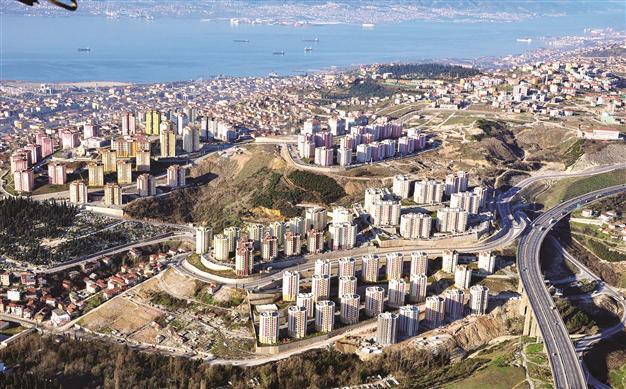Take the foot off the brake, minister tells Central Bank
ISTANBUL

This photo shows new housing blocks in the northwestern province of Kocaeli. The Turkish real estate sector grew around 7 percent in the second quarter year over year. Industrial production, meanwhile, was up 3.4 percent on the back of exports, the minister says. DHA photo
Turkey’s second quarter growth came in lower than expected yesterday at 2.9 percent. The markets had been expecting growth of around 3.2 percent.“The Central Bank should not be late in taking its foot off the break. It is becoming increasingly difficult to achieve more than 4 percent growth this year,” Economy Minister Zafer Çağlayan said in a written statement after the growth figures were released, warning the Central Bank to avoid a larger slowdown when implementing cautious monetary policies.
Finance Minister Mehmet Şimşek said the 2.9 percent growth rate should be considered as being part of a time when the eurozone is contracting and many developing and developed economies have slowed down.
Garanti Investment economist Gizem Öztok Altınsaç believes that there will be a further slowdown in the third quarter and that external demand will play less of a contributing role. “We see that domestic demand has really shrunk ... Private sector investments on a year-over-year basis have witnessed a serious 7.6 point contraction. Domestic consumption is also flat when compared to the same period last year. Growth is lower than expected because the investment demand has narrowed when compared the second quarter of last year,” she said. Altınsaç expects the fourth quarter to be even slower in terms of growth.
Growth driven by exports
HSBC Strategist Fatih Kerestci, meanwhile, noted that the slowdown in growth was already apparent and that yesterday’s figures only confirmed this. “However, when we take a look at the seasonally-adjusted numbers, we see that the slowdown is not too severe. Still, it appears that the trend is around 2.5 to 3 percent below the 4 percent growth target. Therefore, we think it would be appropriate for the Central Bank’s to pull its foot off the break,” he said, calling for the Central Bank to loosen its policies.
Oyak Yatırım Chief Economist Mehmet Besimoğlu believes that the growth was mainly been driven by exports and public sector spending. Minister Çağlayan also stressed that exports had contributed 5.6 points to the 2.9 percent growth rate and that 2012 growth would therefore be entirely driven by exports. “The July and August figures are not that bright. The third quarter is probably going to be worse than the second quarter,” Besimoğlu commented.
Halk Invest Strategist Işık Ökte, however, stressed that she did not believe the figure in itself was enough to change the Central Bank’s policies.
“The second quarter figure was not something we didn’t already know. It is not a number that will make the Central Bank loosen its policies. These policies will continue,” she added.
Turkey’s industrial production index, meanwhile, rose by 3.4 percent in July 2012 over the same month last year, according to the data released yesterday by the Turkish Statistical Institute (TÜİK). Minister Çağlayan also commented on this figure by saying that industrial production needs to be higher and that the 3.4 percent figure was also driven by exports. He said domestic demand needed to do more to support industrial production.
On the sub-sector basis, the mining sector decreased 1.7 percent, while the manufacturing sector index was up by 3 percent. The electricity, gas, steam and air conditioning supply index increased 8.2 percent.
The calendar adjusted production index in July 2012 increased 3.4 percent compared to July 2011, and the seasonal and calendar adjusted industrial production index was up 1.7 percent compared to the previous month.
TÜİK is expected to announced the August current account deficit figure tomorrow and market expectations are for the figure to be way below 10 percent of GDP.
















